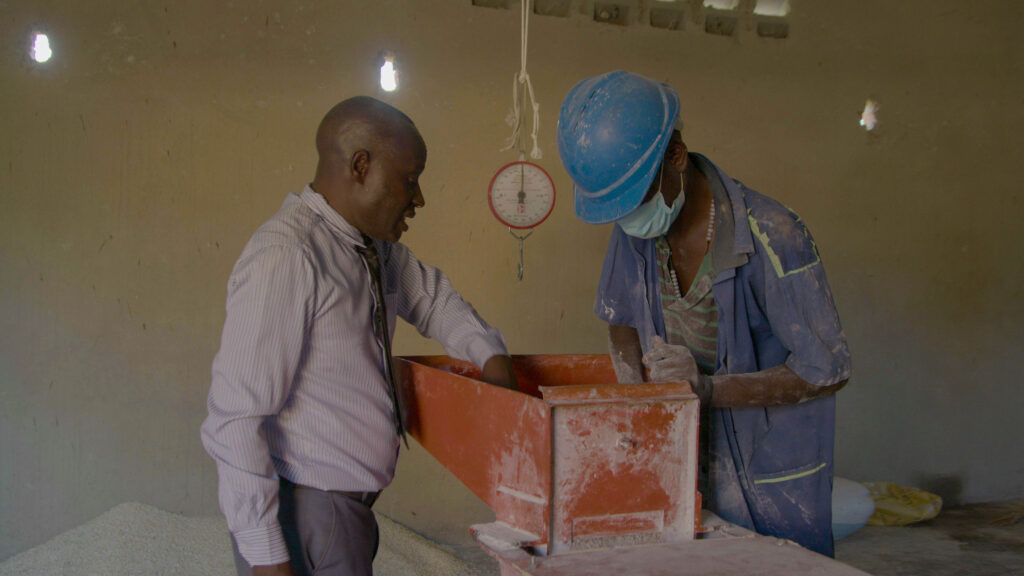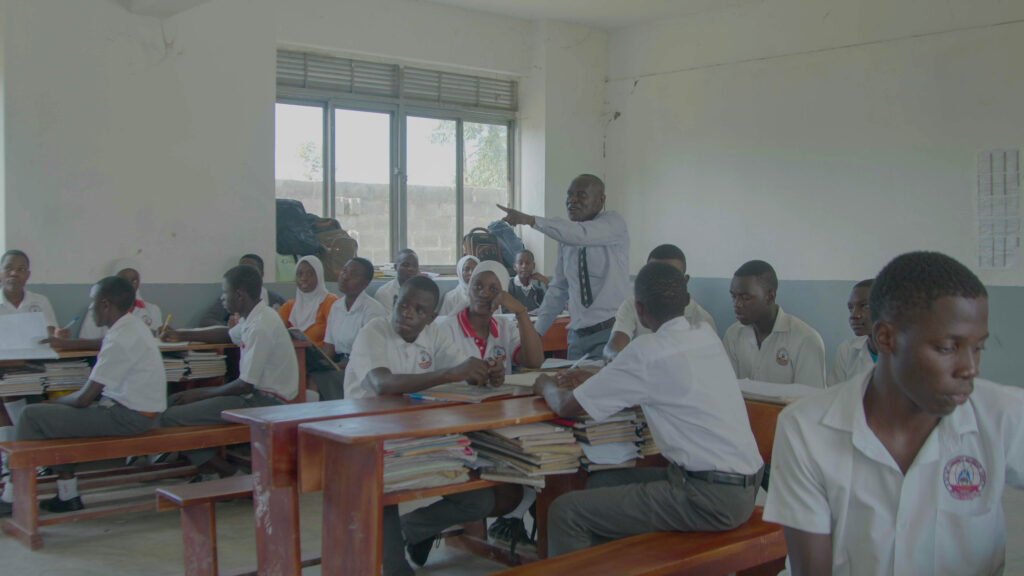Building Together:
Farmers Join Hands to Make, Spend Farm Profits Collectively
Written by: Leticia Mmeeme | Documentary by Dan Ayebare | Film and Photography By Jeremiah Mukiibi
Written by: Leticia Mmeeme | Documentary by Dan Ayebare | Film and Photography By Jeremiah Mukiibi
In Kasasa, a village in Kyotera district central Uganda, an Executive Council of the community’s Saving and Credit Scheme gathers to take a decision on behalf of shareholders.
The pressing matter is about how the savers should spend the over five million shillings in profits generated out of soft loans issued to lenders in the last three months.
“Today’s discussion is crucial, as it will determine the fate of the five million shillings,” says Charles Mukasa as he calls members to vote on the matter.
“You, committee members have an important role in deciding how to invest the money for greater profits,” Mukasa calls the vote.

Charles Mukasa, the Tat Sat Sacco leader visits the milling operator to assess the maize flour quality.
This 30-member committee, which includes students (the much younger generation), the youth, women, and community elders represents and takes decisions on behalf of 300 members of the Tat Sat Community Savings and Credit Cooperative (SACCO), which is the financial lifeline of their community initiative called Tat Sat.
The Tat Sat initiative is a self-sustaining community socio-economic ecosystem built on their staple: the maize crop.
Maize serves Kasasa as both a cash and food crop. The community’s proximity to Tanzania has for long hiked the demand for maize because it is a staple for most communities in Northern Tanzania.
In Uganda, maize, which is produced by about 1.8 million farmers at subsistence level accounts for 40% of the country’s calorie consumption. Processed maize floor is a staple for most households, and also the main food supply for schools, and relief agencies.
In Kasasa, a cocktail of; absence of farm extension services, economic capacity to scale up crop production, and exploitative market middlemen had frustrated most farmers.
In this community, farmers always needed money to increase tillage, buy farm inputs among other things. However, getting credit facilities from commercial banks for example would mean that they stake their land as collateral on top of the high interest rates.
Also, because farm productivity in Uganda depends on natural conditions, the changing weather patterns have made it difficult for commercial banks to assess returns on credit.

Mariam Uwera, a saver with the community Sacco weeds her maize garden.
According to Financial Sector Deepening (FSD) Uganda’s leading ‘think and do tank’ on financial inclusion, as of March 2023, the agricultural sector accounted for 11 percent of the commercial bank credit to the private sector despite accounting for the highest proportion of Uganda’s labour force at 35.9 percent.
“Imagine you’ve planted your maize or beans, and you need to buy fertilizers or pesticides, but the other lending institutions make it difficult for you to access a loan. By the time they approve it, your crops have gone bad,” explains John Mayanja, a member of the Sacco.
The other major challenge for farmers in this community was the middlemen. Although they are usually offered as a link between farmers and markets, they would invade the community during harvest, a period of oversupply for the maize crop. They would buy cheaply, hoard or process, and sell expensively.
Mariam Uweira, 47, has been a maize farmer in this community for more than a decade. Two years ago, UweIra reached out to a middleman to buy her produce in order to raise school fees for her son.
“I was the one who brought the middleman into the deal, naively thinking he could assist me. He deceived me by claiming he had no money, then used a dummy buyer to negotiate on his behalf. Ultimately, I was only paid 200,000 UGX (about 52 USD) for my entire one acre-harvest” says Mariam Uweira
Typically, an acre of maize yields about 10,000 kilograms, and can produce around 750 kilograms of maize flour, potentially earning a farmer about 1.5 million shillings ($405). Uweira was robbed of most of her money.

Students attend class at Tat Sat community school.
The Tatsat Sacco and community initiative represents a shift towards community ownership and sustainable development.
Together, farmers can sustain each other through the community credit system to improve productivity and incomes. The uniqueness of this Sacco is that it supports its members to till their maize gardens, manage them, and ensure a ready market for the produce.
They are able to sell produce and save in the community pool, which is their SACCO. The money is later borrowed in soft loans to improve crop production.
The interest accumulated has been invested in a Secondary School, a Health Center, and a maize milling machine to support education for the community children, improve health access, and add value to the maize to raise income levels.
The Sacco has on-boarded over 300 members, students inclusive, and their ecosystem is solving the many challenges the community has faced
“Our circle currently focuses on three areas: agriculture, investment loans, and business development,” explains Mukasa, the Chairman of Tat Sat Sacco.
“These areas are best fit for the sustainable development in our region,” he adds.
It however faces insurmountable challenges, especially when the maize crop is off-season and loan recovery-related difficulties.
“When a member takes a loan, managing collateral can become complicated,” Mukasa noted. “You need sufficient resources to oversee the security effectively.” Despite these hurdles, the community supports one another, ensuring that maize gardens are well-tended and that members have access to ready markets.
This story was done in collaboration with Proximate
© 2022 - Media Challenge Initiative | All Rights Reserved .
© 2022 - Media Challenge Initiative | All Rights Reserved .